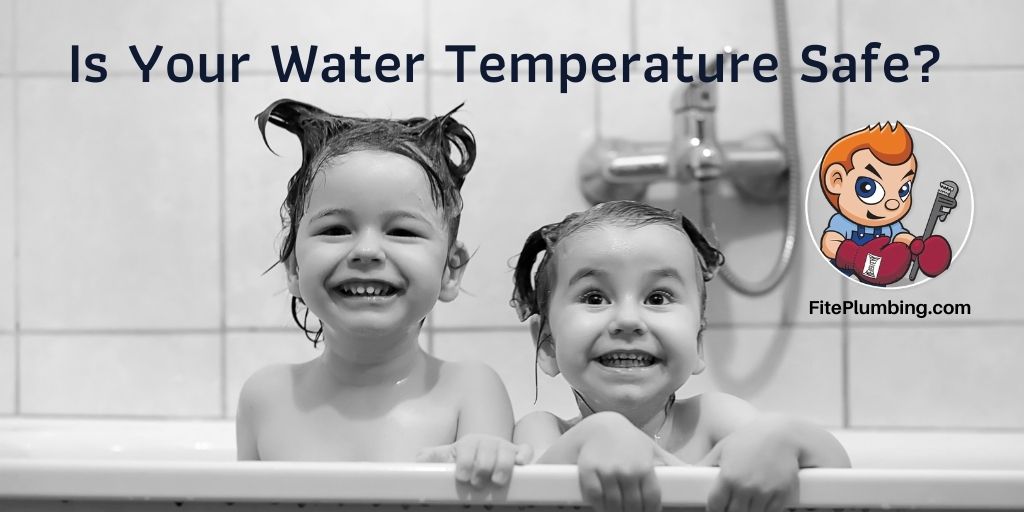Water temperature is important. Did you know that your water heater accounts for about 18% of your home’s energy bill?! If your water heater is set too high, you will be paying the price in your energy bill each month. If it is too high, it can also be dangerous. Turning on the hot water could result in a scald or a dangerous burn. Approximately 3,800 people are injured, and 34 people die each year from excessively hot tap water, according to the Consumer Product Safety Commission.
On the flip side, if your water heater is set too low your water may not get hot enough. You may run out of hot water for your shower. Worse, you could be at risk of growing bacteria. Diseases can develop in the stagnant water inside the water heater, particularly Legionella, which is quite dangerous.
So, what is the best temperature range for your water heater? The Environmental Protection Agency recommends120 degrees because it is hot enough to keep diseases at bay, but it is not hot enough to cause scalding. It will supply enough hot water for most small families and is relatively energy efficient. The best setting for your family could vary based on a few factors:
Type of Plumbing
If your plumbing is PEX, PVC, or copper will impact the temperature of your water.
Type of Energy
Gas or electric power will also impact your water temperature.
Type of Water Heater
The type of water heater you have, tankless or with tank, will also affect the temperature it should be set at.
Dishwashers
If your home has a dishwasher, and it does not preheat the water, you may need to bump up the temperature of your water heater to 140 degrees.
Elderly or Small Children
If you have elderly members of your family or small children living with you, you may want to keep the temperature a bit lower. BabyCenter.com, “It takes just two seconds for a child to receive third-degree burns from water that is 150 degrees and five seconds if it is 140 degrees, the temperatures at which hot water heaters often leave the factory.
Health Challenges
On the other hand, if members of your family have a suppressed immune system or respiratory conditions, you may want to bump the temperature up a bit.
Family Size
The more members of your family living in your home, the more hot water you will need, and you may need to keep the temperature higher. Smaller families use less hot water and you may be able to set the temperature a bit lower.
Economical
If your family is wanting to be very economical and save money on your monthly bills, you may want to turn the temperature down. For every 10 degrees you turn down the water heater tank thermometer, you could save 3 to 5% on your energy bill.
Home Design
Every house is different. If your faucet is farther away from the water the heater, it will take longer for the water to get warm and the warm water will lose some heat as it travels to the faucet. More heat will be lost if your pipes are not insulated. In these cases, you may need to raise your temperature a bit.
How do I Know How Hot my Water Is?
Water heater systems will vary, with different interfaces for controlling temperature, but most can be adjusted similarly. Most newer water heaters have a thermostat panel.
Electric water heaters often have a thermostat at the top and at the bottom of the tank.
No matter which type of water heater you have, you will want to test the temperature before you make adjustments. Turn on the hot water and let it run for 3 minutes or until it is fully hot. Take the water temperature with a thermometer.
How do I Adjust my Water Temperature?
Some water heaters have a dial that you can easily adjust the temperature without any tools needed. Most newer tank water heaters, however, may be a bit more involved, but still not too difficult. Just follow these steps:
- Turn off the power to the water heater at the circuit breaker box
- Find the access panel for the thermostats and remove the panel with a screwdriver.
- Peel back the insulation to access the thermostat.
- Use a screwdriver to adjust the temperature up or down.
- If your water heater has two thermostats, the top thermostat should be set a few degrees higher than the bottom one.
- Replace the insulation over the thermostat.
- Reinstall the access panel.
- Restore the power back to your unit.
Tankless water heaters typically have a display with temperature controls. Similar to the thermostat for your air conditioning, you can use the digital controls to adjust the temperature up or down.
Anytime you adjust the water temperature of your hot water heater, you need to wait at least 3 hours before testing the temperature again and making more adjustments.
If you have adjusted your water heater temperature and you are still experiencing cold showers or scalding water, you may need to a call a professional. We are always here to help! Just give us at Fite Plumbing a call at 317-271-5400.
Are you on Facebook? We are, too. Let’s be friends!


